‘This Is a Clear Violation’: Israel Hits Gaza as Remains Dispute Boils Over
Israel launched strikes after IDF troops come under fire near Rafah and a remains handover is delayed, escalating a ceasefire already strained by accusations of staged recoveries and missed deadlines
Israel launched airstrikes across the Gaza Strip late Tuesday after the Israel Defense Forces (IDF) said Hamas gunmen fired an anti-tank missile and small arms at soldiers near Rafah, an incident officials called a breach of the US-brokered ceasefire. After convening senior security officials, Prime Minister Benjamin Netanyahu ordered the military to carry out “immediate and powerful strikes,” his office said. Shortly afterward, Hamas announced it was postponing a planned handover of another hostage’s remains, blaming “Israeli violations.” The IDF said its reprisals targeted Hamas-used infrastructure and firing points; explosions were reported in Gaza City and Khan Yunis, with tank fire heard from zones under Israeli control. Israeli officials signaled that additional steps were under review if delays continue.
Late-night escalation capped a day of outrage in Israel over a casket transferred via the International Committee of the Red Cross (ICRC) on Monday night that, according to Israeli authorities, held additional remains of Ofir Tzarfati—already recovered and buried months ago—rather than one of the 13 bodies Hamas is obligated to return under the deal. Israeli officials circulated drone footage they said showed Hamas staging the “burial” and “discovery” of Tzarfati’s remains before summoning Red Cross personnel, calling it part of a pattern of psychological warfare. Families of hostages denounced the manipulation. Hamas said it would have returned another set of remains on Tuesday night, but delayed after Israeli airstrikes.
This is a clear violation of the agreement
By day’s end, the debate had been reframed by the expiration of the US president’s 48-hour ultimatum. By Monday night, Hamas had returned only the additional remains of the already-buried Tzarfati, rather than the 13 bodies Israel says the group is still holding. The move drew condemnation in Jerusalem and renewed calls for a sterner response. “This is a clear violation of the agreement,” read a statement from Israeli Prime Minister Benjamin Netanyahu’s office.
“This move is in line with Hamas’ DNA,” Kobi Michael, a senior researcher at the Institute for National Security Studies and the Misgav Institute for National Security and Zionist Strategy, told The Media Line. “They will do whatever it takes to buy time to reestablish their hold on Gaza and exhaust Trump and Israel.”
Earlier Tuesday, Israel’s security cabinet prepared to weigh sanctions; by evening, after the Rafah attack, Netanyahu had gathered decision-makers and approved strikes while signaling possible expansion of Israeli-controlled zones inside Gaza if violations persist. A senior cabinet minister suggested reincarcerating Palestinian prisoners released as part of the ceasefire deal. Israel says roughly 2,000 prisoners have been freed since the agreement took effect on Oct. 13.
Hamas is at one of its weakest points in its history
Warnings that the ceasefire had reached a precarious point predated the Rafah incident. “Hamas is at one of its weakest points in its history,” Shaul Bartal, a research associate at the Begin-Sadat Center for Strategic Studies, told The Media Line. “Its aim is to return to the situation before the war and to be allowed to rearm itself without interruption.”
Give the gift of hope
We practice what we preach:
accurate, fearless journalism. But we can't do it alone.
- On the ground in Gaza, Syria, Israel, Egypt, Pakistan, and more
- Our program trained more than 100 journalists
- Calling out fake news and reporting real facts
- On the ground in Gaza, Syria, Israel, Egypt, Pakistan, and more
- Our program trained more than 100 journalists
- Calling out fake news and reporting real facts
Join us.
Support The Media Line. Save democracy.


Just before midnight Monday, the ICRC handed over the latest remains, intensifying friction over the deal’s implementation. Hamas has said it cannot locate the remaining 13 bodies, citing battlefield and tunnel conditions. Israeli officials dispute that claim, saying the organization knows the burial locations. Officials also say Israel shared intelligence with US channels last week showing that Hamas retains information about most of the remains.
As shots were fired at IDF troops near Rafah on Tuesday, the military returned fire and later struck what it described as Hamas-linked positions. Israeli officials said Jerusalem notified American counterparts in advance and is weighing expanded operational control in parts of Gaza should attacks and problems with the remains transfers continue to stall the truce’s first phase. The government said the objective is to deter attacks on Israeli forces and compel compliance with the remains-for-prisoners mechanism.
Nearly a week separated Monday’s staged return from the prior transfer and placed it well past the timetable in the agreement, which called for the release of all 48 hostages, living and dead, within 72 hours. Israeli officials said the practice of returning previously buried remains breaches both the letter and spirit of the deal. Hamas said searches in tunnel areas are laborious and complicated by the presence of unexploded ordnance and rubble.
“Whoever believes that Hamas will in any way cooperate with Trump’s plan and will voluntarily disarm while giving up its influence on reshaping Gaza is not reading the reality correctly,” Michael said. He added that the longer the first phase drags, the more Hamas gains time to reinsert operatives and reassert control.
We are nearing the point where Trump will also lose patience. … Only the IDF can disarm Hamas.
Reports this week said Washington pressed Israel not to impose harsh punitive measures—such as broad aid restrictions—while mediators tried to salvage the remains-for-prisoners exchanges. The combination of the Rafah attack and the delayed handover shifted the conversation in Jerusalem toward options that keep international partners engaged while increasing pressure on Hamas. “We are nearing the point where Trump will also lose patience,” Michael said. “Everyone will then understand that only the IDF can disarm Hamas.”
The American president has tied the ceasefire’s success to a wider regional track that includes normalization between Israel and key Arab and Gulf states. That vision begins with durable quiet in Gaza and the removal of Hamas from power. “Once Trump realizes Hamas is disrupting his larger regional plans, he will allow Israel to operate militarily,” Michael added. The US president has threatened Hamas with obliteration if it fails to adhere to the deal, a warning echoed by Israeli leaders after the latest breach.
Next steps under the agreement are intended to commence after all hostages have been released and documented remains have been returned. They include the disarmament of Hamas and its removal from power. Israeli officials say the group is deliberately delaying the release of bodies it knows how to locate. Among the remains Israel believes Hamas is holding are those of Col. Asaf Hamami and Lt. Hadar Goldin. Hamami, the former commander of the Gaza Division’s Southern Brigade, is the most senior officer to be taken hostage in Hamas’ Oct. 7, 2023 offensive. Goldin was killed in 2014; Hamas took his body during that war. According to Bartal, those remains are key bargaining chips for Hamas, though the group views holding all Israeli bodies as useful leverage during the ceasefire’s critical first phase.
Inside Gaza, a shadow conflict has intensified. During the two years of war, the IDF began backing and grooming armed groups intended as an alternative to Hamas. After Israeli forces withdrew from much of the Strip under the ceasefire, Hamas moved to reassert control, conducting public executions of suspected members of those militias. “Hamas is buying time,” Bartal explained. “Hamas does not want to make the move to the second phase of the agreement before it has managed to kill as many members of the militias, who they see as collaborators with Israel, thus regaining control in all of the areas that Israel withdrew from.” Videos showed masked men forced to their knees and executed before crowds; after backlash, Hamas is believed to have continued executions more discreetly. “The public executions are meant to send a message that Hamas is here to stay and has no intention of relinquishing power,” Bartal added.
Those armed groups now operate mainly inside the “yellow line” on Gaza’s perimeter, where Israeli forces still hold positions. The militias have been described by Israeli officials as recipients of limited outside backing, including from Arab and Western states, to counter Hamas’s coercive apparatus in areas vacated by the IDF.
Israeli leaders frame the current moment as a test. “Israel agreed to the ceasefire because it vowed to secure the return of all its hostages,” Bartal said. “Israel sees the first phase as a test of whether Hamas will uphold its obligations. If this fails, Israel will consider some sort of military rule in Gaza, through the militias that are already operating in Gaza.” Netanyahu has chaired urgent meetings to formulate Israel’s response, initially to weigh sanctions and now to approve airstrikes and consider broader moves. Defense Minister Israel Katz said the attack on troops “crosses a glaring red line to which the IDF will respond with great force,” adding, “Hamas will pay many times over for attacking the soldiers and for violating the agreement to return the fallen hostages.”
Policy options now on the table include extending operational control zones, targeted escalations, intensified remains-recovery missions, diplomatic pressure, and adjustments to existing arrangements if Hamas continues to delay handovers. The government is also considering steps short of a return to full-scale war, such as limiting certain kinds of aid flows, conducting pinpoint incursions, and restricting medical transfers until compliance improves.
“Israel needs to make Hamas maintain the agreement,” Bartal said. “But there is a catch, and that is the US sponsorship of the deal and the backing by other countries. So now Israel has to aim to impose sanctions, but in coordination with the US.”
Michael added: “Israel will now try to make its case and gain legitimacy by getting the support of all those who backed the plan, in order to allow Israeli forces to operate militarily to completely disarm Gaza, at least in the northern part of the territory.”
The pattern of limited exchanges of fire and delayed returns has pushed the truce into a gray zone: not open war, not durable quiet. Debate in Jerusalem—sanctions first or territory first—collides with Washington’s effort to salvage the broader regional track tied to the US president’s plan. From the anti-tank strike near Rafah to the air raids that followed and the postponed handover, the past 24 hours showed how quickly the ceasefire can fray when either side tests its limits.
For now, Israeli officials say the message is simple: attacks on IDF units and delays on remains will bring consequences. Hamas counters that Israeli actions impede searches and that tunnels and rubble complicate recovery work. Families of the fallen are trapped in the middle, watching deadlines slip while waiting for final returns that remain out of reach.

